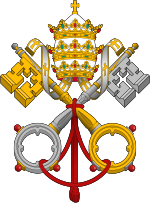Pope Callixtus III
| Callixtus III | |
|---|---|
 |
|
| Papacy began | April 8, 1455 |
| Papacy ended | August 6, 1458 |
| Predecessor | Nicholas V |
| Successor | Pius II |
| Personal details | |
| Birth name | Alfonso de Borja |
| Born | December 31, 1378 Canals, Valencia, Crown of Aragon |
| Died | 6 August 1458 (aged 79) Rome, Papal States |
| Other Popes named Callixtus | |
Pope Callixtus III (December 31, 1378 – August 6, 1458) (Catalan: Calixt III, Spanish: Calixto III), né Alfons de Borja, was Pope from April 8, 1455 to his death in 1458.[1]
Contents |
Biography
Alfonso de Borja was born in La Torreta, now a neighbourhood of Canals, València, today Spain but then Kingdom of Valencia under the Crown of Aragon. His early career was spent as a professor of law at University of Lleida and then as a diplomat in the service of the Kings of Aragon, especially during the Council of Basel (1431–1439). He became a cardinal after reconciling Pope Eugene IV (1431–1447) with King Alfonso V of Aragon (1416–1458).
| Papal styles of Pope Callixtus III |
|
|---|---|
 |
|
| Reference style | His Holiness |
| Spoken style | Your Holiness |
| Religious style | Holy Father |
| Posthumous style | None |
He was raised to the papal chair in 1455 as Callixtus III at a very advanced age as a compromise candidate. He was viewed by historians as being feeble and incompetent. In 1456, he issued the papal bull Inter Caetera to Portugal (not to be confused with Inter Caetera of 1493). This bull reaffirmed the Portuguese right to reduce infidels and Africans to servitude by the earlier bull of Romanus Pontifex and Dum Diversas. . By doing this the pope reaffirmed the church's consent of the enslavement of Africans. This confirmation of Romanus Pontifex also gave the Portuguese the military Order of Christ, which was under Prince Henry the Navigator.[2]
This was, however, in direct opposition to the stance set by Pope Eugene IV in his bull "Sicut Dudum" of 1435, wherein the said infidels are said to have nonetheless been created in the image of God, and being thus created had reasonable souls, whereby no Christian man could take his liberty.
The great object of his policy was the urging of a crusade against the Turks, who had captured Constantinople in 1453, but he did not find the Christian princes responsive to his call despite his every effort.
Pope Callixtus III made two of his nephews cardinals, one of whom, Roderic de Borgia, later became Pope Alexander VI (1492–1503) and was infamous for corruption.[3]
On June 29, 1456, he ordered the bells to be rung at noon (see noon bell) in all Catholic churches to call Christians for prayer. As news spread with some delay, this order became connected with the crusade to lift the Siege of Belgrade (which happened on July 22), which was a signal victory against the Turks. To commemorate this victory, Callixtus III ordered the feast of the Transfiguration to be held on August 6.
He ordered a new trial for St. Joan of Arc (c. 1412–1431), at which she was posthumously vindicated after being controversially tried and executed.[4]
Callixtus III's pre-papal coat of arms featured a grazing ox.
The "bull against the comet"
According to one story, first appearing in a posthumous biography in 1475 and later embellished and popularized by Pierre-Simon Laplace, Callixtus III excommunicated the 1456 apparition of Halley's Comet, believing it to be an ill omen for the Christian defenders of Belgrade, who were at that time being besieged by the armies of the Ottoman Empire. No known primary source supports the authenticity of this account. Callixtus III's papal bull of June 29, 1456, which called for public prayer for the success of the crusade, makes no mention of the comet, and by August 6, when the Turkish siege was broken, the comet had not been visible from Europe or Turkey for several weeks.
Notes
- ↑ Hibbert, Christopher, The Borgias and their enemies: 1431-1519, (Houghton Mifflin Harcourt, 2008), 11.
- ↑ European treaties bearing on the history of the United States and its Dependencies to 1648, Ed. Frances Gardiner Davenport, (Carnegie Institute of Washington, 1917), 27.
- ↑ The Lives and Times of the Popes, Vol.4, Ed. Artaud de Montor, (Catholic Publication Society of America, 1911), 190.
- ↑ Gower, Ronald Sutherland, Joan of Arc, (BiblioBazaar LLC, 2007), 180.
References
- European treaties bearing on the history of the United States and its Dependencies to 1648, Ed. Frances Gardiner Davenport, Carnegie Institute of Washington, 1917.
- Gower, Ronald Sutherland, Joan of Arc, BiblioBazaar LLC, 2007.
- Hibbert, Christopher, The Borgias and their enemies: 1431-1519, Houghton Mifflin Harcourt, 2008.
- The Lives and Times of the Popes, Vol.4, Ed. Artaud de Montor, Catholic Publication Society of America, 1911.
Outside Links
- European treaties bearing on the history of the United States and its Dependencies to 1648, Ed. Frances Gardiner Davenport, Carnegie Institute of Washington, 1917. http://www.questia.com/PM.qst?a=o&d=23628818
| Catholic Church titles | ||
|---|---|---|
| Preceded by Nicholas V |
Pope 1455–1458 |
Succeeded by Pius II |
|
|||||||||||||||||||||||||||||||||||||||||||||
|
|||||||||||||||||||||||||||||||||||||||||

